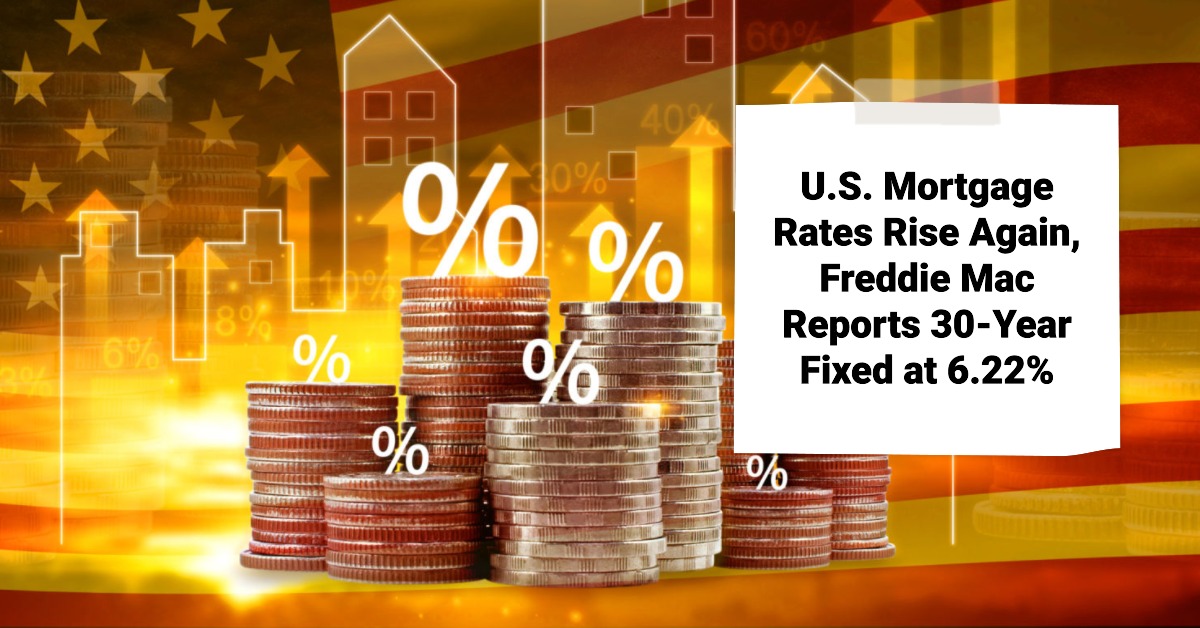This is a big week for anyone looking to buy a home or refinance an existing mortgage, as Freddie Mac reported mortgage rates increased to 6.22% for a 30-year fixed loan. This news comes as a bit of a shift after a few weeks of steady declines, and it’s important for homebuyers to understand what this means for their budgets and their search.
Mortgage Rates Rise With 30-Year FRM Climbing to 6.22%
As of the week ending November 6, 2025, the average rate for a 30-year fixed-rate mortgage hit 6.22%, a jump of 0.05 percentage points from the 6.17% recorded the week before. This marks an end to a four-week streak where rates had been inching downward. For context, while this is a slight uptick, it's still notably lower than the 6.79% we saw around this time last year in November 2024.
What’s Pushing Rates Up (and What It Means)
It might seem a bit confusing that mortgage rates are ticking up even after the Federal Reserve recently cut its main interest rate. The reality is, mortgage rates are influenced by a complex web of factors, and the Federal Reserve’s actions are just one piece of the puzzle.
Based on my experience observing these trends, I believe the key driver here, as highlighted by Freddie Mac's report, is the cautious language coming from Federal Reserve Chair Jerome Powell regarding future rate cuts. When the Fed signals that it might not be as aggressive with future rate reductions as the market initially hoped, investors often reprice their bonds. This repricing can lead directly to a rise in mortgage rates. Bond yields and mortgage rates often move in similar directions because mortgage-backed securities (think of them as bundles of mortgages that investors buy) are essentially bonds.
Another critical factor is the yield on the 10-year Treasury note. This is often considered the bellwether for long-term borrowing costs, including mortgages. When Treasury yields go up, mortgage rates typically follow suit. The economic climate, including recent uncertainties like government shutdowns, can also cause market volatility. This uncertainty can lead investors to seek safer investments, like Treasury bonds, which can indirectly influence mortgage rates.
Digging Deeper: The 10-Year Treasury Note’s Role
I often explain to people that while the Federal Reserve controls the short-term federal funds rate, mortgage rates are much more closely tied to long-term interest rates. The most important of these is the 10-year Treasury note yield.
Why is this one so important? Think about how long most people stay in their homes before moving or refinancing. It’s usually in the 7- to 10-year range. So, for lenders and investors who buy mortgages, the yield on a 10-year Treasury note offers a good benchmark for what borrowers might pay over a similar, extended period.
When the economy feels shaky, investors tend to flock to the 10-year Treasury because it's considered a very safe place to put their money. This increased demand drives the price of the bond up and, in turn, its yield down. Conversely, if investors are feeling more confident, they might move their money out of these safe havens, pushing Treasury prices down and yields up.
Lenders don't just offer you the Treasury yield; they add a bit extra, called a “spread.” This spread covers their costs, the risk involved, and their profit. So, a rising 10-year Treasury yield, combined with the lender's spread, directly translates to a higher mortgage rate for you.
What This Means for Borrowers Right Now
While the 6.22% rate is a slight increase, Freddie Mac's Chief Economist, Sam Khater, offers a perspective that’s worth noting. He mentioned that rates are still near their 2025 lows. This is crucial because even a small increase doesn't completely erase the affordability improvements we've seen this year compared to earlier in 2025.
For homebuyers, this means:
- Increased Monthly Payments: If you were eyeing a specific home price, a jump from 6.17% to 6.22% will mean your principal and interest payment will be slightly higher each month.
- Revisiting Budgets: It’s a good time to re-evaluate your budget. You might need to adjust your price range or look for homes with fewer amenities to stay within your comfort zone.
- Shopping Around: This is always critical, but especially now. While the average is 6.22%, different lenders will offer different rates based on your credit score, down payment, and other factors. Don't settle for the first offer you get.
The 15-Year Fixed-Rate Mortgage:
It’s not just the 30-year rate that moved. The 15-year fixed-rate mortgage also saw an increase, now averaging 5.50% with 0.0 points. This is up from 5.41% the previous week. A year ago, this rate was at 6.00%. While still lower than the 30-year option, it reflects the same upward pressure in the market.
Looking Ahead: What’s Next for Mortgage Rates?
The crystal ball for mortgage rates is always a bit cloudy, but most of the experts I follow, including those at Freddie Mac, Fannie Mae, and the Mortgage Bankers Association (MBA), anticipate that we'll likely see rates hover in the low to mid-6% range for the next few months. A significant drop below 6% in the immediate future doesn’t seem to be in the cards for most forecasts.
Here’s a quick look at some of the thinking:
- Economy Slowing Down: The general consensus is that as the U.S. economy continues to cool down and inflation moderates towards the Fed's goals, there's a chance for rates to ease slightly.
- Fed's Cautious Approach: Even with rate cuts, the Fed is still focused on making sure inflation is truly licked. This means they're likely to remain cautious, which prevents dramatic plunges in mortgage rates.
- Continued Volatility: Unexpected economic news or global events can still create bumps in the road, leading to day-to-day or week-to-week fluctuations.
Diverging Forecasts for 2026:
| Institution | Forecasted Rate (End of 2026) | Notes |
|---|---|---|
| Fannie Mae | Around 5.9% | More optimistic about rate decreases. |
| Mortgage Bankers Association (MBA) | Around 6.4% | Expects rates to remain higher. |
| Freddie Mac (Current) | Low to mid-6% range | Anticipates some potential for slight declines. |
The “Buy Now, Refinance Later” Strategy
With these forecasts in mind, many professionals are suggesting a strategy that makes a lot of sense in the current market: “buy now and refinance later.”
Here’s the logic behind it: Home prices are still expected to increase over the coming years. If you lock in a home purchase now, even at a slightly higher interest rate, the appreciation in your home's value could end up offsetting the extra interest you pay, especially if you can refinance to a lower rate in a year or two when rates might eventually fall further. This strategy is a way to get into the market sooner rather than waiting for that perfect, low rate, which may not materialize for quite some time.
This recent update from Freddie Mac is a reminder that the housing market is dynamic. Staying informed and understanding the forces at play, like the average 30-year fixed mortgage rate reaching 6.22%, empowers you to make the best decisions for your financial future.
Turnkey Rentals Help You Retire Early and Hedge Against Inflation
Turnkey real estate offers powerful tax benefits, monthly cash flow, and long-term equity growth—ideal for early retirement planning.
Norada Real Estate helps you invest in inflation-resistant markets with strong rental demand and built-in tax advantages like depreciation and 1031 exchanges.
🔥 HOT NEW LISTINGS JUST ADDED! 🔥
Talk to a Norada investment counselor today (No Obligation):
(800) 611-3060
Also Read:
- How Buyers Can Lock In a Sub-1% Mortgage Rate in 2025
- Mortgage Rates Predictions for 2025 and 2026 by Fannie Mae
- Mortgage Rates Predictions for the Latter Half of 2025 by Norada Real Estate
- Will Mortgage Rates Go Down in 2025: Morgan Stanley's Forecast
- Mortgage Rates Predictions by Top Industry Experts 2025-2026
- Mortgage Rate Predictions for the Next 3 Years: 2026, 2027, 2028
- 30-Year Fixed Mortgage Rate Forecast for the Next 5 Years
- 15-Year Fixed Mortgage Rate Predictions for Next 5 Years: 2025-2029
- Will Mortgage Rates Ever Be 3% Again in the Future?
- Mortgage Rates Predictions for Next 2 Years
- Mortgage Rate Predictions for Next 5 Years
- Mortgage Rate Predictions: Why 2% and 3% Rates are Out of Reach
- How Lower Mortgage Rates Can Save You Thousands?
- How to Get a Low Mortgage Interest Rate?
- Will Mortgage Rates Ever Be 4% Again?



